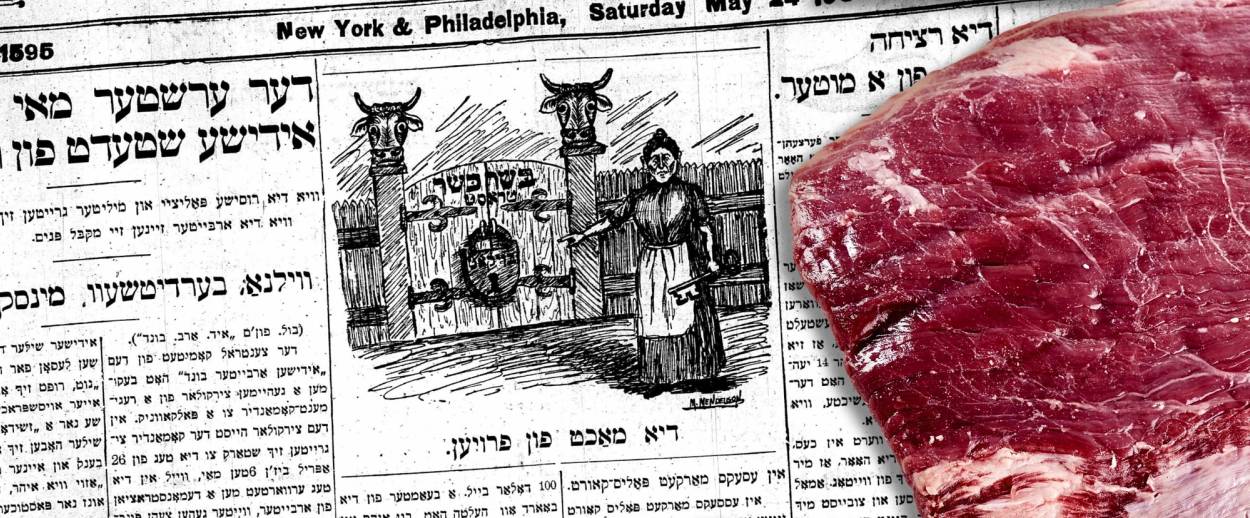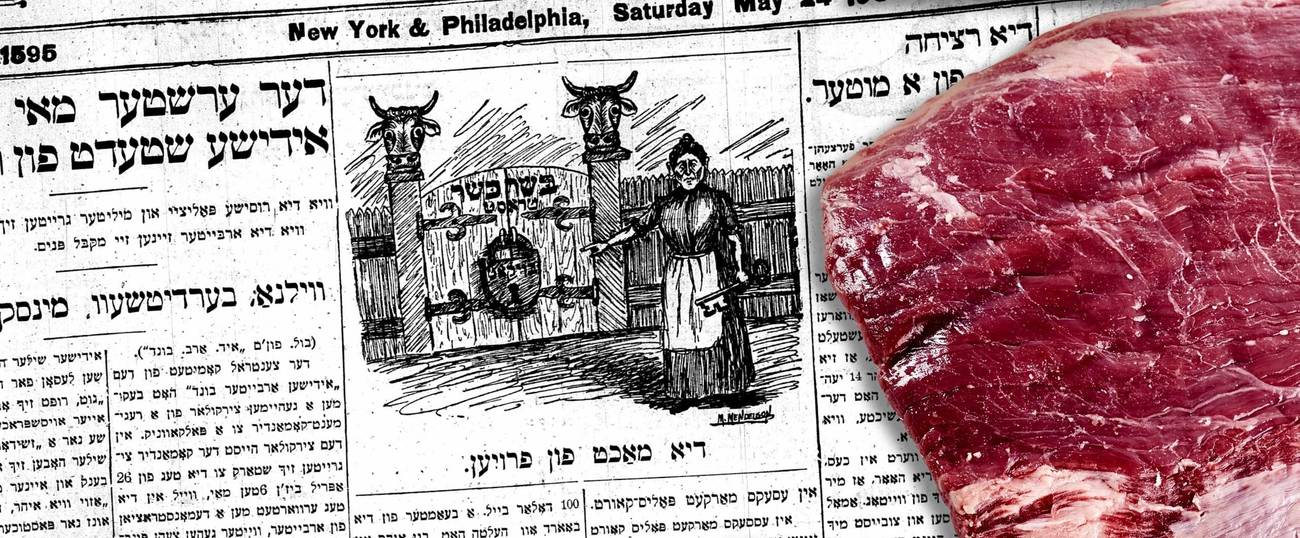Lessons From the Kosher Meat Boycott
What today’s women activists can learn from a little-known uprising in 1902




Last week, three well-known women activists—Cecile Richards, the former head of Planned Parenthood; Alice Garza, the co-founder of Black Lives Matter; and Ai-jen Poo, the leader of the National Domestic Workers Alliance—launched an advocacy organization called Supermajority. Their goal: to get women organized for the 2020 election. The trio could take a lesson from a surprisingly effective and surprisingly little-known women’s uprising that happened over a hundred years ago: the Kosher Meat Boycott of 1902.
On May 15, 1902, the Lower East Side’s Jewish housewives took to the streets in a meat-hurling frenzy. They were rebelling against a huge bump in the price of meat—from 12 to 18 cents a pound. The “Meat Trust,” a shadowy collective that supplied the city’s kosher meat, had jacked up wholesale costs. Local shops initially tried to protest; they stopped selling meat for a week. But the Meat Trust was unbending. Small businesses gave up the fight, agreeing to pass the price hike on to the consumer.
But local women would have none of it. According to the late historian Paula Hyman, in her classic “Immigrant Women and Consumer Protest: The New York Kosher Meat Boycott of 1902,” published in The American Jewish Experience (1997), the impeus to fight came from one Mrs. Levy, the wife of a cloakmaker. She shouted, “This is their strike? Look at the good it has brought! Now if women make a strike, then it will be a strike!” That day, May 14, Mrs. Levy and Mrs. Edelson, a small restaurant owner, called a mass meeting to plan a boycott. All over the Lower East Side, women began passing out Yiddish flyers illustrated with skulls and crossbones, urging, “Eat no meat while the Trust is taking meat from the bones of your women and children.”
The next morning, women began attacking butcher shops. They threw meat into the streets and stomped on it, broke windows, and yanked packages of beef out of customers’ hands. When one shopper protested that her sick husband needed red meat, an elderly religious woman snapped, “A sick man can eat treyf meat.” (True.)
The riots continued for days. Women visited their neighbors to sniff each other’s pots for meat. On Shabbat, May 17, they streamed out of the balconies during the Torah reading to bring attention to the cause. When a man told Mrs. Silver, one of the women who led the synagogue protest, that she had chutzpah and her action was a hillul Hashem (a desecration of God’s name), she coolly replied that the Torah would pardon her. Women marched and shouted, “We will not be silent; we will overturn the world” and called themselves “soldiers in the great women’s war.” Orthodox Jews and socialist/anarchists, who pretty much agreed on nothing, fought side by side.
The New York Times reported in horror that women, “armed with sticks, vocabularies, and well sharpened nails” attacked the police. “Old shoes, brushes, combs, brooms, and every other imaginable portable article of household use rained down upon the pavement,” the Times fretted. “Among the prisoners were two little girls, who with others had shouted at an officer, refused to stay back of the lines, and finally leaped on the policeman, tore one of his coat sleeves off and threw him down in the mud of the gutter.” Another policeman “had an unpleasant moist piece of liver slapped in his face.”
At least 70 women were arrested. A disapproving judge asked one of the women, Rosa Peskin, “Did you throw meat in the street?” She replied, “Certainly. I should have looked it in the teeth?” The community went door to door raising bail money for her and others.
On May 21, male communal leaders decided to get involved. They had a meeting of their own and informed the women that they could now back off because the men would handle things. They published a flyer noting that “brave and honest men are now aiding women.” Yay, men.
On June 5, the Meat Trust backed down. They lowered their prices; the butchers then dropped theirs down to a more reasonable 14 cents a pound.
Today, we know this story because of Paula Hyman’s writing. Hyman’s daughter, Judith Rosenbaum, the director of the Jewish Women’s Archive, told me what happened. “During the summer of ’77 there was the blackout and all kinds of unrest, and people compared the rioters to animals. The historian Herb Gutman wrote an op-ed in The New York Times saying that how we see marginalized people depends on context. He quoted a piece in the Times calling rioters animals.” (As Gutman recounted, the Times wrote: “They have no inbred or acquired respect for law and order as the basis of the life of the society into which they have come. … The instant they take the law into their own hands, the instant they begin the destruction of property and assail peaceable citizens and the police, they should be handled in a way that they can understand and cannot forget.”)
After letting the reader think the quote was recent, Gutman sprang a gotcha: The quote was not about African Americans and Puerto Ricans in New York City in 1977; it was about Jewish housewives in New York City in 1902. Rosenbaum continued, “The rest of the op-ed talked about the uses of language, but my mom wanted to know more about the women’s boycott, so she asked Gutman. My recollection is that he wasn’t all that helpful because he really was not that interested in Jewish women; it was just a hook for his essay. But that’s what got her into researching the riots herself.”
Gutman’s point about language is still relevant: Protesters today are frequently depicted—even by the purportedly unbiased media—as lawless, mindless animals. The Times called the 1902 strikers “very ignorant,” noting darkly that “they mostly speak a foreign language.” The paper was also invested in depicting the police in a positive light: “It was noticeable throughout the melee that the policemen kept their heads perfectly,” the Times reported. “They did all they could to prevent serious injuries to those they strove against, and used their sticks more to frighten than to chastise. The way they handled the thousands, or rather the tens of thousands, for before the trouble had been in progress an hour all the streets were crowded for a half a mile in all directions, was commented upon as remarkable by all who witnessed the affair.” The police even hit the women gently, “[b]elaboring the less sensitive parts of the rioters’ bodies with their clubs.”
This narrative hasn’t changed much in a century. Only the identity of the villains has changed. Police violence is as timely a subject as ever, as is the way it’s depicted—and often excused—by the media. But there are still relevant takeaways from the 1902 action for Richards, Garza, and Poo.
1. Building bridges among women of different backgrounds works. Battles are rarely won all at once; there was a second meat boycott in May 1935. This one was led by labor organizer Clara Lemlich and crossed religious and racial lines as well as economic and cultural ones, with pickets against kosher butchers downtown and nonkosher butchers in Harlem. Within a month, over a thousand shops dropped their prices; within three months, JWA notes, women were striking against high meat prices in Detroit, Chicago, Philadelphia, St. Louis, Indianapolis, and Denver. In New York City, the strikers were Jewish and African American, but nationwide, the strike was taken up by women of all backgrounds. It was also an early example of women from around the country taking buses to Washington, D.C., to lobby government officials.
2. Men will always tell women they don’t understand how the world works. In 1902, “Magistrate Cornell told the women brought before him that they did not understand the condition of the beef market,” the Times reported. And yet somehow beef prices dropped following their actions. Curious.
3. When the immediacy and danger are clear, even formerly politically unengaged women will show up. The participants in the meat boycott weren’t the same women as those fighting in the garment factories. They weren’t young; they weren’t active in the labor movement. Their average age was 39 and the average number of children they had was four. As Hyman wrote, “Although mainly immigrants, most of the women had been living in the United States for many years and were asserting what they saw as American rights—the right to demand fair prices, the right to protest publicly, and the right to speak freely and openly.” The cause was something clearly relevant to their day-to-day lives: feeding their families. And they saw how community outreach was effective. “The boycott would become a model for future protests and was in many ways a precursor to larger scale strikes, including the 1909 shirtwaist strike,” Hyman wrote.
4. It’s up to women to tell women’s stories. Historiography and history are not the same thing. Marginalized people, including women, need to be the keepers and sharers of tales about their own roles in social change … because men generally won’t do it.
5. Action feels better than inaction. As one woman arrested in 1902, Rebecca Ablowitz, told the judge, “If we stay home and cry, what good will that do us?”
***
Like this article? Sign up for our Daily Digest to get Tablet magazine’s new content in your inbox each morning.
Marjorie Ingall is a former columnist for Tablet, the author of Mamaleh Knows Best, and a frequent contributor to the New York Times Book Review.